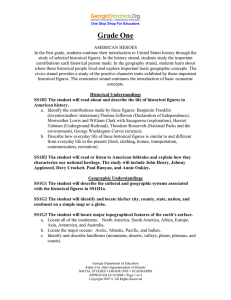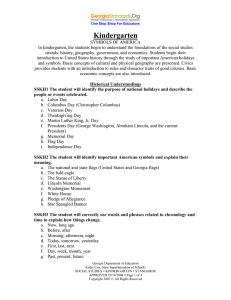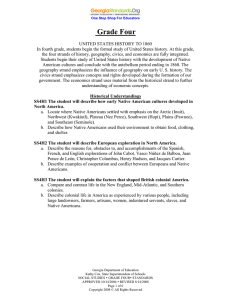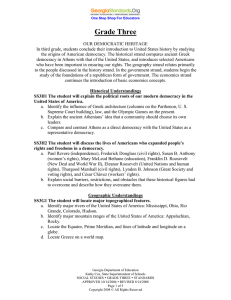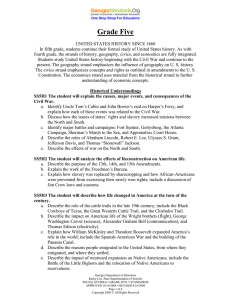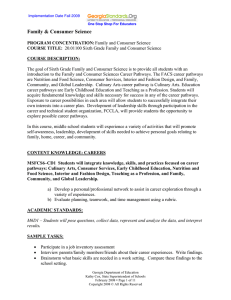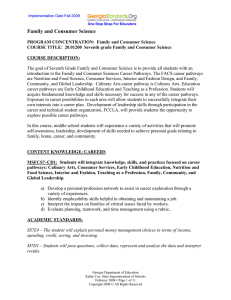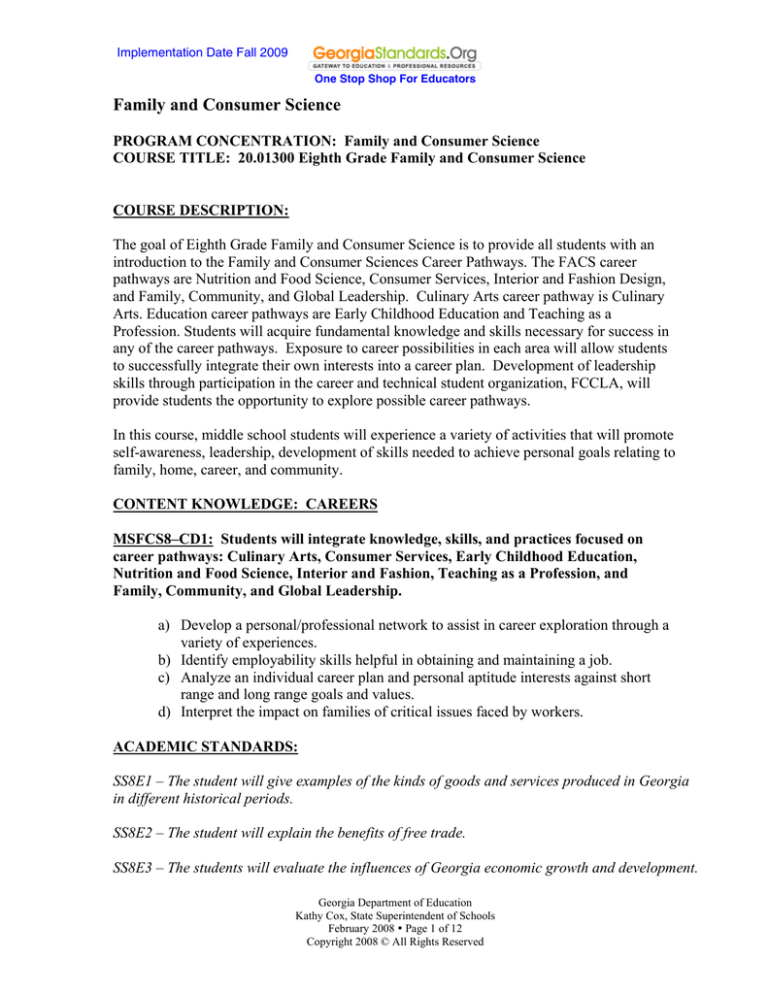
Implementation Date Fall 2009
One Stop Shop For Educators
Family and Consumer Science
PROGRAM CONCENTRATION: Family and Consumer Science
COURSE TITLE: 20.01300 Eighth Grade Family and Consumer Science
COURSE DESCRIPTION:
The goal of Eighth Grade Family and Consumer Science is to provide all students with an
introduction to the Family and Consumer Sciences Career Pathways. The FACS career
pathways are Nutrition and Food Science, Consumer Services, Interior and Fashion Design,
and Family, Community, and Global Leadership. Culinary Arts career pathway is Culinary
Arts. Education career pathways are Early Childhood Education and Teaching as a
Profession. Students will acquire fundamental knowledge and skills necessary for success in
any of the career pathways. Exposure to career possibilities in each area will allow students
to successfully integrate their own interests into a career plan. Development of leadership
skills through participation in the career and technical student organization, FCCLA, will
provide students the opportunity to explore possible career pathways.
In this course, middle school students will experience a variety of activities that will promote
self-awareness, leadership, development of skills needed to achieve personal goals relating to
family, home, career, and community.
CONTENT KNOWLEDGE: CAREERS
MSFCS8–CD1: Students will integrate knowledge, skills, and practices focused on
career pathways: Culinary Arts, Consumer Services, Early Childhood Education,
Nutrition and Food Science, Interior and Fashion, Teaching as a Profession, and
Family, Community, and Global Leadership.
a) Develop a personal/professional network to assist in career exploration through a
variety of experiences.
b) Identify employability skills helpful in obtaining and maintaining a job.
c) Analyze an individual career plan and personal aptitude interests against short
range and long range goals and values.
d) Interpret the impact on families of critical issues faced by workers.
ACADEMIC STANDARDS:
SS8E1 – The student will give examples of the kinds of goods and services produced in Georgia
in different historical periods.
SS8E2 – The student will explain the benefits of free trade.
SS8E3 – The students will evaluate the influences of Georgia economic growth and development.
Georgia Department of Education
Kathy Cox, State Superintendent of Schools
February 2008 y Page 1 of 12
Copyright 2008 © All Rights Reserved
Implementation Date Fall 2009
One Stop Shop For Educators
SAMPLE TASKS:
•
•
•
•
•
•
•
Use a job inventory tool to create a career profile and planning guide.
Use entrepreneurship skills to create and manage a school wide business (cookie
sales, café, and school supply store).
Have students create an interview packet and role play the interviewing process.
Discuss appropriate business etiquette.
Work on a Job Shadow site for one seven hour day.
Compare job applications.
Practice completing job applications.
CONTENT KNOWLEDGE: EARLY CHILDHOOD EDUCATION
MSFCS8–ECE1: Students will analyze human growth and development and demonstrate
the integration of knowledge, skills and practices of the caregiver-educator roles.
a)
b)
c)
d)
e)
Discuss principles of human growth and development.
Assess conditions that influence human growth and development.
Identify factors that affect growth and development.
Investigate the roles and responsibilities of parents and caregivers.
Analyze career paths within early childhood education and childcare services.
ACADEMIC STANDARDS:
SS8CG1 – The student will describe the role of citizens under Georgia constitution.
SS8E4 – The students will identify revenue sources and services provided by state and local
governments.
SAMPLE TASKS:
•
•
•
•
•
•
Identify correct parenting and caregiver techniques using case studies.
Interview parents and caregivers comparing opinions on the roles and responsibilities
of parents and caregivers.
Research different cultures and parenting techniques.
Invite guest speakers to share about ECE careers.
Take a fieldtrip to a childcare center to observe.
Research birth defects and share information using power point presentation.
Georgia Department of Education
Kathy Cox, State Superintendent of Schools
February 2008 y Page 2 of 12
Copyright 2008 © All Rights Reserved
Implementation Date Fall 2009
One Stop Shop For Educators
CONTENT KNOWLEDGE: FOOD, NUTRITION, AND WELLNESS
MSFCS8–FNW1: Students will apply principles of food science, food technology, and
nutrition and their relationships to growth, development, health, and wellness to support
informed decision-making that promotes good health.
a)
b)
c)
d)
Demonstrate dietetic and nutrition management principles and practices.
Distinguish between a healthy diet and fads, food addictions and eating disorders.
Demonstrate strategies and skills used to set personal health goals.
Recognize safety and sanitation standards and practices in selection, preparation,
handling and food storage.
e) Identify and demonstrate acceptable behaviors for table service and etiquette.
f) Research cultural influences on individual family food preferences and practices.
ACADEMIC STANDARDS:
SS8E1 – The student will give examples of the kinds of goods and service produced in Georgia
in different historical periods.
S8CS1 – Students will explore the importance of curiosity, honesty, openness, and skepticism in
science and will exhibit these traits in their own efforts to understand how the world works.
S8CS2 – Students will use standard safety practices for all classroom laboratory and field
investigations.
S8CS3 – Students will have the computation and estimation skills necessary for analyzing data
and following scientific explanations.
S8CS4 – Students will use tools and instruments for observing, measuring, and manipulating
equipment and materials in scientific activities utilizing safe laboratory procedures.
S8CS7 – Students will question scientific claims and arguments effectively.
SAMPLE TASKS:
•
•
•
•
•
•
Research different agricultural products grown and distributed in Georgia.
Demonstrate the standard safety practices for classroom use.
Apply information from www.mypyramid.gov. to set personal health goals.
Investigate the history of etiquette/table manners; write a speech convincing others
about the importance of dining etiquette.
Research current health issues affecting children and teens and how to improve these
conditions/share findings.
Review use of kitchen tools and equipment.
Georgia Department of Education
Kathy Cox, State Superintendent of Schools
February 2008 y Page 3 of 12
Copyright 2008 © All Rights Reserved
Implementation Date Fall 2009
One Stop Shop For Educators
CONTENT KNOWLEDGE: FOODS (CULINARY ARTS)
MSFCS8–FCA1: Students will demonstrate food preparation and service knowledge
and skills.
a) Students will implement kitchen management through proper use of kitchen
equipment and utensils.
b) Students will consistently apply food safety and sanitation guidelines.
c) Students will utilize the dietary guidelines and mypyramid.gov to develop meal
plans and menus.
d) Identify and practice the basic concepts of food production.
ACADEMIC STANDARDS:
SS8E1 – The student will give examples of the kinds of goods and service produced in Georgia
in different historical periods.
S8CS1 – Students will explore the importance of curiosity, honesty, openness, and skepticism
in science and will exhibit these traits in their own efforts to understand how the world
works.
S8CS2 – Students will use standard safety practices for all classroom laboratory and field
investigations.
S8CS3 – Students will have the computation and estimation skills necessary for analyzing data
and following scientific explanations.
S8CS4 – Students will use tools and instruments for observing, measuring, and manipulating
equipment and materials in scientific activities utilizing safe laboratory procedures.
S8CS7 – Students will question scientific claims and arguments effectively.
SAMPLE TASKS:
•
•
•
•
•
•
•
Prepare foods using Georgia grown agricultural products.
Plan and prepare a simple menu, plan tablescape and table setting/have each table invite
a teacher to attend
Develop weekly menus using mypyramid.gov.
Use internet sources to analyze the weekly menus for nutrition information.
Use classroom recipes to practice increasing and decreasing the yield of recipes.
Create variations of a recipe by using a master mix.
Investigate commercial food preparation through guest speakers and field trips.
Georgia Department of Education
Kathy Cox, State Superintendent of Schools
February 2008 y Page 4 of 12
Copyright 2008 © All Rights Reserved
Implementation Date Fall 2009
One Stop Shop For Educators
CONTENT KNOWLEDGE: CONSUMER AND FINANCE
MSFCS8–CF1: Students will identify and discuss social and financial skills needed to
develop personal independence and interpersonal relationships.
a) Explain the responsibilities associated with managing personal finances.
b) Analyze factors in developing short term and long term financial goals.
c) Demonstrate financial literacy and money management strategies in areas of budgeting.
ACADEMIC STANDARDS:
SS8CG4 – The student will analyze the role of the judicial branch in Georgia state government.
SS8E5 – The student will explain the benefits of free trade.
SS8H12 – The student will explain the importance of significant social, economic, and political
development in Georgia since 1970.
SAMPLE TASKS:
•
•
•
•
•
•
•
•
Create a family budget using case studies.
Diagram the theory of supply and demand/give examples of current supply and demand
issues.
Investigate/compare the various services available through community banking institutions.
Research the impact of Georgia legislation on family financial decisions.
Field trip to Atlanta Federal Reserve Bank or a virtual tour of the Federal Reserve
(www.FRBAtlanta.org).
Practice check writing skills and check book management by using a simulation kit.
Play a budget game.
Invite banking personnel to present information about banking careers.
MSFCS8–CF2: Students will analyze factors (social, psychological, economic, cultural)
affecting consumer and management decisions for individual and families and how
those decisions impact society.
a)
b)
c)
d)
e)
f)
Identify the types of available credit.
Compare and contrast sources of credit.
Analyze the cost and limitations of credit.
Apply ways consumer rights, responsibilities and policies protect consumers.
Critique ways advertising influences consumer decisions.
Describe the impact of technology on consumers.
Georgia Department of Education
Kathy Cox, State Superintendent of Schools
February 2008 y Page 5 of 12
Copyright 2008 © All Rights Reserved
Implementation Date Fall 2009
One Stop Shop For Educators
ACADEMIC STANDARDS:
SS8CG4 – The student will analyze the role of the judicial branch in Georgia state government.
M8P5 – Students will represent mathematics in multiple ways.
SAMPLE TASKS:
•
•
•
•
•
•
•
Interview parents/other adults to learn about online banking practices.
Research the impact of Georgia legislation on family financial decisions.
Invite local senator or state representative to share information on Georgia and family
financial decisions.
Discuss the relationship between emotions and spending.
Use www.practicalmoneyskills.com website to investigate saving and investing money
(also has check writing, balancing checkbook, etc.)
Evaluate the cost of credit using case studies.
Estimate the cost of loans on homes and cars/explore ways to cut this cost.
CONTENT KNOWLEDGE: INTERIOR DESIGN
MSFCS8–ID1: Students will analyze factors (social, psychological, economic, cultural)
affecting housing and interior design decisions for individuals and families and how
those decisions impact society.
a) Identify specific consideration and/or adaptations that would improve a living
space for individual with disabling conditions.
b) Apply the elements and principles of design by creating a project.
c) Explain ways to conserve natural resources in family, school, work and/or community
settings.
d) Identify the impact of technology on residential and commercial design.
ACADEMIC STANDARDS:
M8P5 – Students will represent mathematics in multiple ways.
S8CS3 – Students will have the computation and estimation skills necessary for analyzing data
and following scientific explanations.
SAMPLE TASKS:
•
•
Investigate adaptations needed with various disabling conditions (design a room with
these modifications in mind).
Design a room (kitchen, living room, bedroom, bath, dining) include all the elements
of design.
Georgia Department of Education
Kathy Cox, State Superintendent of Schools
February 2008 y Page 6 of 12
Copyright 2008 © All Rights Reserved
Implementation Date Fall 2009
One Stop Shop For Educators
•
•
•
Research different housing options and compare their cost.
Create a “Green Living” project.
Invite an interior design professional to share the impact of technology on residential
design.
CONTENT KNOWLEDGE: FASHION DESIGN
MSFCS8–FD1: Students will analyze factors (social, psychological, economic, cultural)
affecting textile and apparel decisions for individuals and families and how those
decisions impact society.
a)
b)
c)
d)
e)
Identify appropriate clothing for individual’s roles and activities.
Assess personal wardrobe.
Investigate clothing and its impact on a person’s self-concept/self-esteem.
Identify daily, weekly, and seasonal care of clothing and accessories.
Use creative ideas and materials to personalize an individual and/or group project.
ACADEMIC STANDARDS:
M8P5 – Students will represent mathematics in multiple ways.
S8CS3 – Students will have the computation and estimation skills necessary for analyzing data
and following scientific explanations.
SAMPLE TASKS:
•
•
•
•
•
Using an inventory guide evaluate personal wardrobe/use findings to clean out and
organize personal wardrobe.
Create a visual of appropriate clothing for various situations social, job interviews,
school, free time and family occasions.
Present a fashion show using the school dress code as your guidelines.
Home project have students sort, wash, dry, and put away three loads of laundry.
Create a project that requires various mending skills to be used.
CONTENT KNOWLEDGE: FAMILY, COMMUNITY, AND LEADERSHIP
MSFCS8–FCGL1: Students will demonstrate teamwork, leadership skills, and
knowledge to become leaders in the family, workplace, and community.
a) Identify the elements of an environment that encourages and respects the ideas,
perspectives, and contributions of all group members.
b) Discuss community and civic responsibilities, volunteerism, volunteer
management and recognition, and social services.
Georgia Department of Education
Kathy Cox, State Superintendent of Schools
February 2008 y Page 7 of 12
Copyright 2008 © All Rights Reserved
Implementation Date Fall 2009
One Stop Shop For Educators
c) Analyze the characteristics of people who are valued leaders and citizens in the
community.
d) Develop a project that demonstrates leadership skills.
ACADEMIC STANDARDS:
M8P1 – Students will solve problems (using appropriate technology).
M8P3 – Students will communicate mathematically.
M8P4 – Students will make connections among mathematical ideas and to other disciplines.
M8P5 – Students will represent mathematics in multiple ways.
SAMPLE TASKS:
•
Use FCCLA programs: Dynamic Leadership
Power of One
Community Service
F.A.C.T.S. (Families Acting for Community Traffic Safety)
Financial Fitness
Student Body
Families First
Leaders at Work
STAR Events
Career Connections
Stop the Violence
READING STANDARD COMMENT:
After the elementary years, students are seriously engaged in reading for learning.
This process sweeps across all disciplinary domains, extending even to the area of personal
learning. Students encounter a variety of informational as well as fictional texts, and they
experience text in all genres and modes of discourse. In the study of various disciplines of
learning (language arts, mathematics, science, social studies), students must learn through
reading the communities of discourse of each of those disciplines. Each subject has its own
specific vocabulary, and for students to excel in all subjects, they must learn the specific
vocabulary of those subject areas in context.
Beginning with the middle grade years, students begin to self-select reading materials
based on personal interests established through classroom learning. Students become curious
about science, mathematics, history, and literature as they form contexts for those subjects
related to their personal and classroom experiences. As students explore academic areas
through reading, they develop favorite subjects and become confident in their verbal
discourse about those subjects.
Georgia Department of Education
Kathy Cox, State Superintendent of Schools
February 2008 y Page 8 of 12
Copyright 2008 © All Rights Reserved
Implementation Date Fall 2009
One Stop Shop For Educators
Reading across curriculum content develops both academic and personal interests in
students. As students read, they develop both content and contextual vocabulary. They also
build good habits for reading, researching, and learning. The Reading Across the Curriculum
standard focuses on the academic and personal skills students acquire as they read in all areas
of learning.
CTAEMRC-1: Students will enhance reading in all curriculum areas by:
a. Reading in all curriculum areas.
• Read a minimum of 25 grade-level appropriate books per year from a variety
of subject disciplines and participate in discussions related to curricular
learning in all areas.
• Read both informational and fictional texts in a variety of genres and modes
of discourse.
• Read technical texts related to various subject areas.
b. Discussing books.
• Discuss messages and themes from books in all subject areas.
• Respond to a variety of texts in multiple modes of discourse.
• Relate messages and themes from one subject area to messages and themes in
another area.
• Evaluate the merit of texts in every subject discipline.
• Examine author’s purpose in writing.
• Recognize the features of disciplinary texts.
c. Building vocabulary knowledge.
• Demonstrate an understanding of contextual vocabulary in various subjects.
• Use content vocabulary in writing and speaking.
• Explore understanding of new words found in subject area texts.
d. Establishing context.
• Explore life experiences related to subject area content.
• Discuss in both writing and speaking how certain words are subject area
related.
• Determine strategies for finding content and contextual meaning for unknown
words.
WRITING:
The student writes clear, coherent text. The writing shows consideration of the audience and
purpose. The student progresses through the stages of the writing process (e.g., prewriting,
drafting, revising, and editing successive versions).
CTAEW-1: The student demonstrates competence in a variety of genres.
The student produces technical writing (business correspondence: memoranda, emails, letters
of inquiry, letters of complaint, instructions and procedures, lab reports, slide presentations)
that:
Georgia Department of Education
Kathy Cox, State Superintendent of Schools
February 2008 y Page 9 of 12
Copyright 2008 © All Rights Reserved
Implementation Date Fall 2009
One Stop Shop For Educators
a) Creates or follows an organizing structure appropriate to purpose, audience, and
context.
b) Excludes extraneous and inappropriate information.
c) Follows an organizational pattern appropriate to the type of composition.
d) Applies rules of Standard English.
CTAEW-2: The student uses research and technology to support writing.
The student:
a) Identifies topics, asks and evaluates questions, and develops ideas leading to
inquiry, investigation, and research.
b) Uses organizational features of electronic text (e.g., bulletin boards, databases,
keyword searches, e-mail addresses) to locate relevant information.
c) Includes researched information in different types of products (e.g., compositions,
multimedia presentations, graphic organizers, projects, etc.).
d) Uses appropriate structures to ensure coherence (e.g., transition elements).
e) Supports statements and claims with anecdotes, descriptions, facts and statistics,
and specific examples.
f) Gives credit for both quoted and paraphrased information in a bibliography by
using a consistent and sanctioned format and methodology for citations.
CTAEW-3: The student consistently uses the writing process to develop, revise, and
evaluate writing.
The student:
a) Plans and drafts independently and resourcefully.
b) Uses strategies of note taking, outlining, and summarizing to impose structure on
composition drafts.
c) Edits writing to improve word choice after checking the precision of the vocabulary.
ENTREPRENEURSHIP:
MKT-EN-1: Understands concepts and processes associated with successful
entrepreneurial performance.
a)
b)
c)
d)
e)
f)
g)
h)
i)
Define entrepreneurship.
Identify and analyze characteristics of a successful entrepreneur.
Identify the reasons for planning in entrepreneurial businesses.
Discuss the entrepreneurial discovery processes.
Assess global trends and opportunities.
Determine opportunities for business creation.
Generate ideas for business.
Determine feasibility of ideas.
Determine the major reasons for business failure.
Georgia Department of Education
Kathy Cox, State Superintendent of Schools
February 2008 y Page 10 of 12
Copyright 2008 © All Rights Reserved
Implementation Date Fall 2009
One Stop Shop For Educators
ACADEMIC STANDARDS:
ELA8W1 – The student produces writing that establishes an appropriate organizational
structure, sets a context and engages the reader, maintains a coherent focus throughout, and
signals a satisfying closure.
ELA8W3 – The student uses research and technology to support writing.
SSEF6 – The student will explain how productivity, economic growth and future standards of
living are influenced by investment in factories, machinery, new technology and the health,
education and training of people.
SSEIN1 – The student will explain why individuals, businesses and governments trade goods
and services.
MKT-EN-2: Explain the fundamental concepts of business ownership.
a)
b)
c)
d)
e)
f)
g)
h)
i)
j)
Determine the relationship of competition to our private, free enterprise system.
Explain the effects of competition on buyers and sellers.
Identify the common types of business ownership.
Compare and contrast the advantages and disadvantages of each type of ownership.
Explain relevant government regulations relating to the operation of a business.
Discuss the types of risks that businesses encounter.
Explain how businesses deal with the various types of risks.
Identify the market segment for the business.
Formulate a marketing mix designed to reach a specific market segment.
Utilize the marketing functions to determine the competitive advantage of the
proposed business.
ACADEMIC STANDARDS:
ELA8W1 – The student produces writing that establishes an appropriate organizational
structure, sets a context and engages the reader, maintains a coherent focus throughout, and
signals a satisfying closure.
ELA8W3 – The student uses research and technology to support writing.
SSEF5 – The student will describe the roles of government in a market economy.
CTAE FOUNDATION SKILLS:
The Foundation Skills for Career, Technical and Agricultural Education (CTAE) are
critical competencies that students pursuing any career pathway should exhibit to be
successful. As core standards for all career pathways in all program concentrations, these
Georgia Department of Education
Kathy Cox, State Superintendent of Schools
February 2008 y Page 11 of 12
Copyright 2008 © All Rights Reserved
Implementation Date Fall 2009
One Stop Shop For Educators
skills link career, technical and agricultural education to the state’s academic performance
standards.
The CTAE Foundation Skills are aligned to the foundation of the U.S. Department of
Education’s 16 Career Clusters. Endorsed by the National Career Technical Education
Foundation (NCTEF) and the National Association of State Directors of Career Technical
Education Consortium (NASDCTEc), the foundation skills were developed from an analysis
of all pathways in the sixteen occupational areas. These standards were identified and
validated by a national advisory group of employers, secondary and postsecondary educators,
labor associations, and other stakeholders. The Knowledge and Skills provide learners a
broad foundation for managing lifelong learning and career transitions in a rapidly changing
economy.
CTAE-FS-1 Technical Skills: Learners achieve technical content skills necessary to pursue
the full range of careers for all pathways in the program concentration.
CTAE-FS-2 Academic Foundations: Learners achieve state academic standards at or above
grade level.
CTAE-FS-3 Communications: Learners use various communication skills in expressing
and interpreting information.
CTAE-FS-4 Problem Solving and Critical Thinking: Learners define and solve problems,
and use problem-solving and improvement methods and tools.
CTAE-FS-5 Information Technology Applications: Learners use multiple information
technology devices to access, organize, process, transmit, and communicate information.
CTAE-FS-6 Systems: Learners understand a variety of organizational structures and functions.
CTAE-FS-7 Safety, Health and Environment: Learners employ safety, health and environmental
management systems in corporations and comprehend their importance to organizational
performance and regulatory compliance.
CTAE-FS-8 Leadership and Teamwork: Learners apply leadership and teamwork skills in
collaborating with others to accomplish organizational goals and objectives.
CTAE-FS-9 Ethics and Legal Responsibilities: Learners commit to work ethics, behavior,
and legal responsibilities in the workplace.
CTAE-FS-10 Career Development: Learners plan and manage academic-career plans and
employment relations.
CTAE-FS-11 Entrepreneurship: Learners demonstrate understanding of concepts,
processes, and behaviors associated with successful entrepreneurial performance.
Georgia Department of Education
Kathy Cox, State Superintendent of Schools
February 2008 y Page 12 of 12
Copyright 2008 © All Rights Reserved

